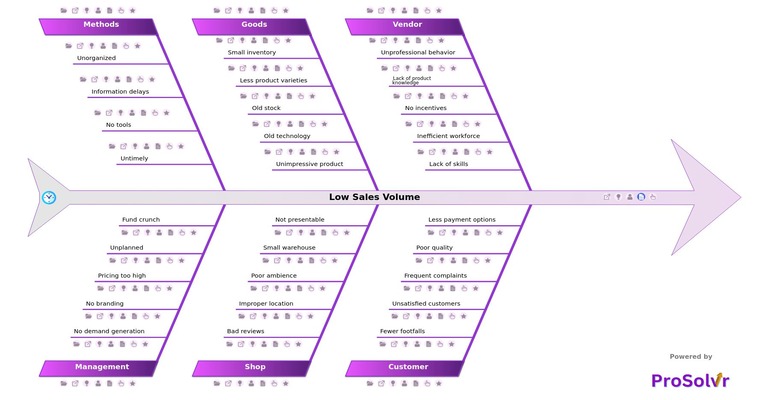Root Cause Analysis of Low Sales Volume
Sales volume metrics are pivotal indicators of business health, meticulously tracking the quantity of products or services sold over defined periods. They serve as barometers for evaluating the efficacy of marketing endeavors and sales force performances, crucial for strategic decision-making regarding physical store placements. A slump in sales not only jeopardizes growth trajectories but also undermines revenue generation, the lifeblood of any thriving enterprise. A dwindling sales volume often unveils underlying issues with product performance and sales methodologies, necessitating a comprehensive Root Cause Analysis (RCA) approach ingrained with methodologies like the 5 Whys and Fishbone diagrams, emblematic of Six Sigma principles.
Crafting robust marketing strategies not only amplifies revenue streams but also fortifies brand presence in fiercely competitive markets. Moreover, meticulous competitor analyses empower businesses to carve niches and capitalize on burgeoning opportunities. Delving deeper into customer preferences and tailoring offerings accordingly is paramount, engendering heightened customer satisfaction and fostering brand loyalty. Yet, the landscape of low sales volume is multifaceted, encompassing vendor dynamics, customer feedback, product quality, shop ambiance, operational methodologies, and managerial oversight.
From rectifying unprofessional vendor behaviors to optimizing product quality and streamlining sales processes, each facet demands meticulous attention. Unsatisfied customers, dwindling foot traffic, and limited payment options compound the challenges on the consumer front, while shop reputations, geographical placements, and spatial aesthetics impact footfalls significantly. Methodological enhancements, ranging from structured information dissemination to optimized organizational workflows, are imperative for rectifying operational inefficiencies. Strategic management interventions, embracing demand generation tactics, brand enhancement initiatives, pricing optimizations, and fiscal prudency, are instrumental in orchestrating a holistic resurgence from low sales volumes, buttressed by Corrective and Preventive Actions (CAPA) rooted in RCA methodologies, thereby augmenting quality and reliability across sales pipelines.
In conclusion, the fishbone diagram encapsulates a comprehensive root cause analysis, shedding light on the critical drivers behind the plummet in sales volume. This visual representation not only delineates the key factors but also offers a professional and intuitive insight into the intricacies of the sales downturn. By identifying and addressing these root causes effectively, businesses can strategize with precision, fostering proactive measures to bolster sales performance and ensure sustained growth.
Who should use the Low Sales Volume template?
- The Low Sales Volume template is invaluable for businesses across various industries facing a decline in sales. It serves as a strategic tool for sales managers, marketing teams, and business owners seeking to diagnose and rectify the underlying causes contributing to the decrease in sales volume. Additionally, it can benefit operational managers, product managers, and financial analysts in understanding the broader implications of low sales volume on business performance and devising targeted solutions. Ultimately, any organization striving to optimize sales performance and enhance revenue streams can leverage the Low Sales Volume template to drive informed decision-making and proactive action.
Why use the Low Sales Volume template?
- Diagnosis of Root Causes: It provides a structured approach to identify and analyze the root causes behind the low sales volume. By utilizing tools such as the fishbone diagram, businesses can uncover underlying issues across various aspects of their operations, from product quality to marketing strategies.
- Data-Driven Insights: The template encourages data-driven decision-making by enabling businesses to collect and analyze relevant data related to sales performance. This data-driven approach ensures that interventions and strategies are based on concrete evidence rather than assumptions.
- Strategic Planning: Understanding the root causes of low sales volume allows businesses to develop targeted and effective strategies to address them. Whether it involves improving product quality, enhancing marketing efforts, or optimizing sales processes, the template serves as a roadmap for strategic planning.
- Resource Allocation: By pinpointing the key factors contributing to low sales volume, the template helps businesses allocate resources more efficiently. It ensures that resources are directed towards initiatives that have the most significant impact on improving sales performance.
- Continuous Improvement: The Low Sales Volume template fosters a culture of continuous improvement within an organization. By regularly revisiting and updating the analysis, businesses can adapt to changing market conditions and continuously strive to optimize their sales processes.
Low sales volume presents a significant challenge for businesses, signaling underlying issues that need urgent attention. It not only hampers revenue generation but also raises concerns about the overall health of the business. Low sales volume can stem from various factors, including ineffective marketing strategies, poor product quality, intense competition, economic downturns, or shifts in consumer preferences. Moreover, it can lead to decreased cash flow, inventory backlog, and reduced profitability, further exacerbating the situation. Addressing low sales volume requires a holistic approach, involving meticulous analysis, strategic planning, and proactive measures to identify root causes and implement targeted solutions. Without swift and effective intervention, businesses risk stagnation or decline in the competitive market landscape.
Draft and create a template for problem analysis in ProSolvr by smartQED.
Curated from community experience and public sources:








